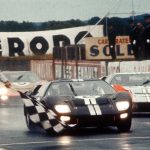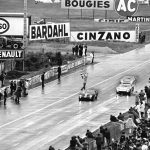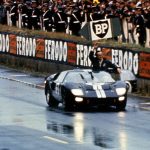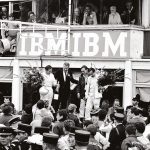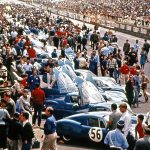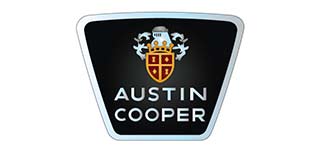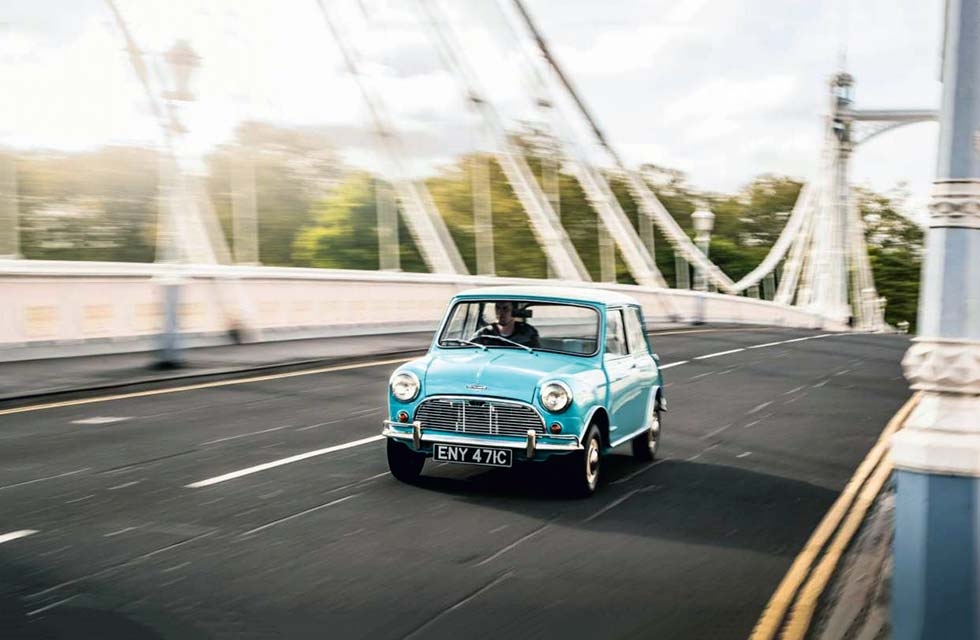
Mini: The Trendsetter The Mini is seen as shorthand for Swinging Sixties London, right? We explore the truth of its iconic status with the help of fashion pioneer Mary Quant and an Austin Cooper S. Words Sam Dawson. Photography Charlie Magee.
THE TRENDSETTER SWINGING IN TOWN
Chasing the true swinging Sixties in a Cooper 1275S
‘You can take racing lines on urban streets at what feels like breakneck speed’
Swinging in Town We take a Cooper S on a zip across the capital city it so famously conquered, and quiz fashion designer and Mary Quant on its wider cultural impact
On a dusty corner at the end of a row of Georgian mews houses in West London, a weary tabloid-newspaper photographer sits in his old Ford Consul. It’s five in the morning. His bleary eyes remain fixed on one of the upper-floor front doors mid-way down the cobbled lane.
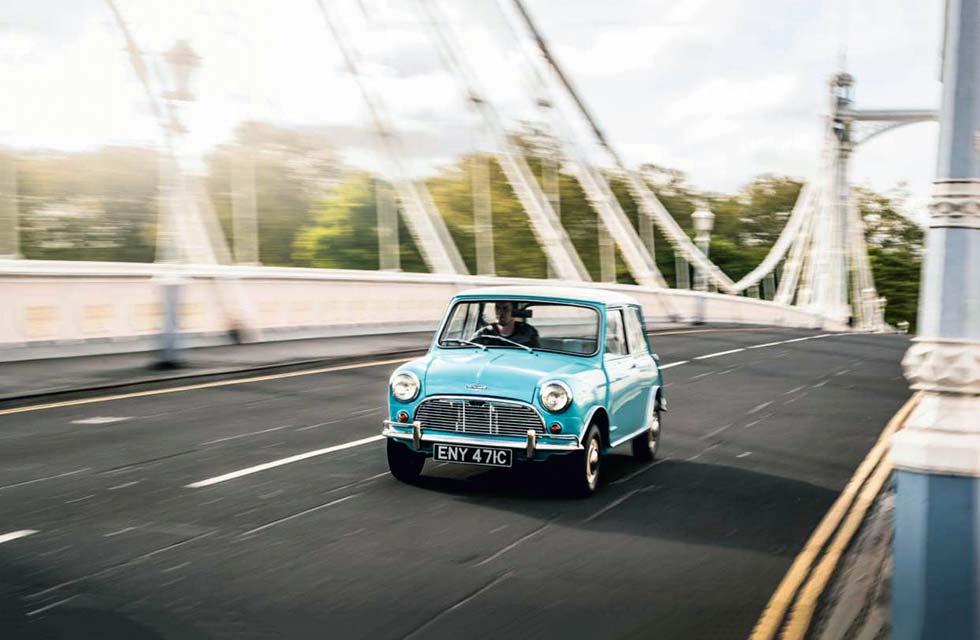
Suddenly, there’s activity. A light flicks on, the door creaks open, and a young couple, barely into their twenties, emerge. They’re not in traditional Holland Park attire – him unshaven, with shaggy hair and a purple shirt open to his navel, her in a skimpy acid-green dress that ends way above her knees. Hangovers hide behind bug-eyed white plastic-framed sunglasses. The photographer’s long-range lens emerges from the Consul’s open window. They look nervously around before getting into a baked-beano-range Mini Cooper S, and tearing off into the backstreets at a rate the snapper’s Consul can’t hope to match. No matter. The rock star’s affair with the actress and the drug-fuelled party-will be all over the front page by the late edition. And BMC dealers will smile because their baby car is the backdrop to every shot.
‘For the name of her new range of above-the-knee skirts, Quant turned to her car for inspiration’
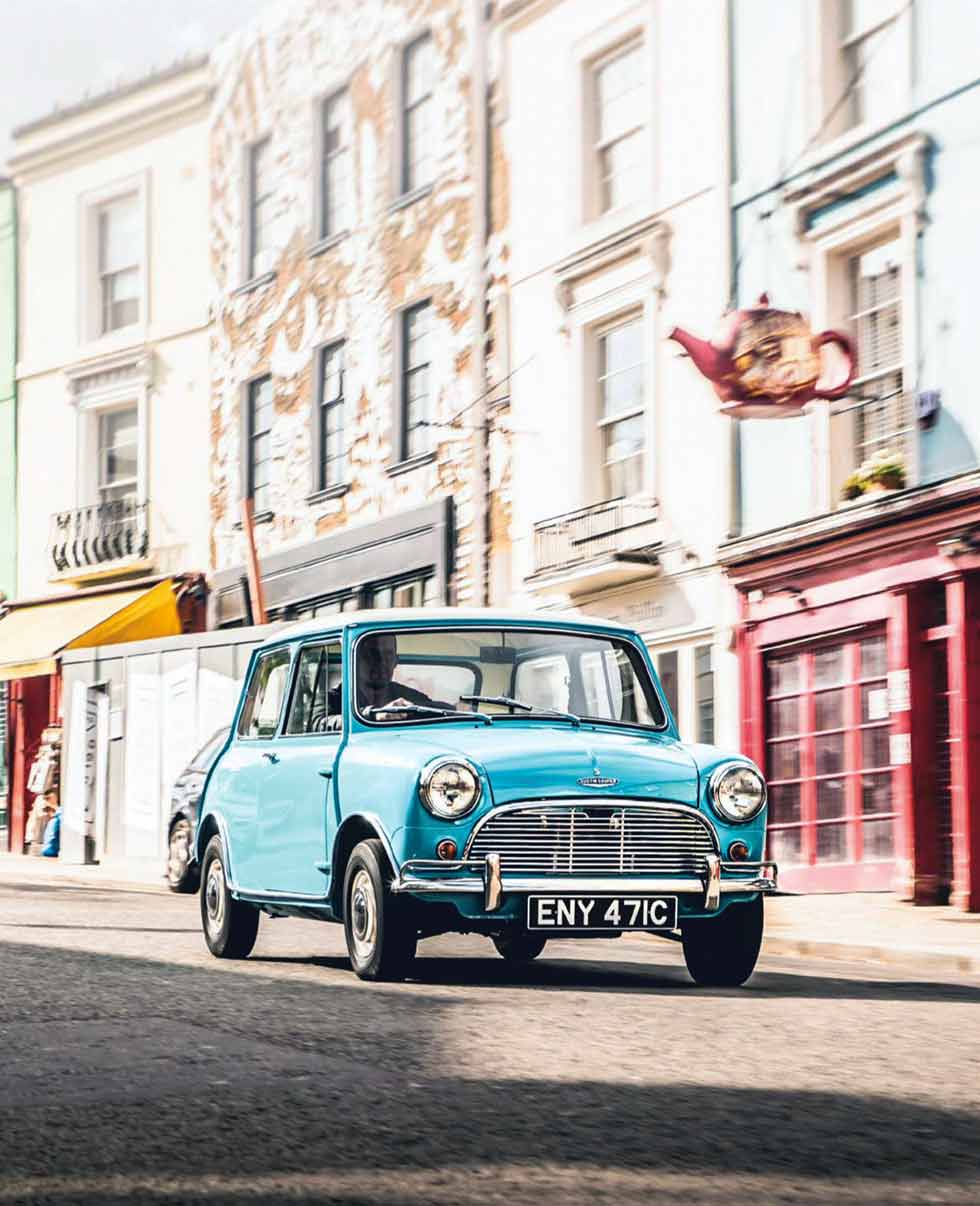
Did this sort of thing really happen, or was it just in our imaginations? In our collective social memory, the Mini is followed around by a parade of clichés like screaming teenage girls after a Beatle. But there’s no avoiding the fact that the Mini has an image most manufacturers couldn’t hope to invent even if they tried. Anyone in the market for a small British car could just as easily have contemplated a Ford Anglia or a Hillman Imp, yet you never see old photos of pop stars getting into them.
Today, I’m in West London in search of the cultural and social factors that made the Mini so much more special than its rivals. My transport for the day is a 1966 Cooper 1275S. Its rare Surf Blue paintwork dazzles beneath the deciduous fronds of Battersea Park like the carapace of an exotic beetle, belying the instant familiarity of its shape. Climbing aboard, I’m struck by how much room there is for heads, knees and elbows – every bit of interior space is usable and unintrusive. It’s airy in here, a sense elevated by the bright, reflective interior fabrics. The starter motor whirrs noisily before the A-series engine splutters and snarls into life. Barely silenced, it might as well be in my lap. Instantly, I know this is going to be no motorway wafter, but it will be fun, and endlessly communicative. The Hydrolastic suspension bobs over the speed humps like an eager spaniel puppy as I turn to cross the Thames.
We’re not headed for the hackneyed cliché-zones of Carnaby Street and Soho, but rather the King’s Road, Chelsea. It was here, in 1955, that fashion designer Mary Quant set up Bazaar, her first boutique. In 1962, following a style trend that began with Fifties American science-fiction costume-designers, and having observed young career women running for buses on the street outside Bazaar, Quant introduced a new range of above-the-knee skirts and dresses that also neatly avoided purchase-tax by using sufficiently little fabric as to qualify them as childrens’ clothes. For the name, Quant turned to her new car for inspiration. The miniskirt was thus named after her Mini Cooper. By niftily miniaturising the word ‘miniature’, a car had influenced the English language itself.
Recalls Quant today, ‘There are many, similar characteristics between the fun, run-around small car – ideal for the young to whizz between work and evening activities – and the ever-shorter skirts that provided freedom of movement and reflected the exuberance and joy that young people were experiencing in the Sixties. Both were part of that exciting and vibrant period where anything seemed possible.’
This combination of inner-suburban locations, youthful entrepreneurship and consumerism provides greater clues to the cultural significance of the Mini than anything its creator, Alec Issigonis, might have intended. With its design process accelerated in response to the 1956 Suez Crisis, this was supposed to be an economy car for economy-minded buyers, but Issigonis’ thinking ran deeper than that. With its compact dimensions, this was a car for a new, modernist era of city living; of concrete tower-blocks in places like Harlowand Bowwith their Le Corbusier-inspired ‘streets in the sky’, and equally concrete flyovers, interchanges, bypasses and gyratories soaring around urban areas connecting home with work and leisure. The deliberately basic nature of the Mini’s design betrayed another of the Issigonis’ intentions – it was supposed to be an ultra-affordable car for a new generation of working-class drivers who’d perhaps previously have chosen a bubble-car or motorcycle-and- sidecar combination. It wasn’t supposed to be a lifestyle accessory for the chattering classes.
With the Suez Crisis over but still influencing buying habits, Harold Macmillan’s government encouraged the population to go on a spending spree. The 1959 ‘You’ve never had it so good!’ election campaign reduced purchase tax on new cars from 60 to 50 per cent and hire-purchase-restricting credit-controls were scrapped. People who couldn’t previously have justified buying a new car felt free to do so, but to Issigonis’ – and BMC’s – horror, they didn’t opt for Minis. Issigonis, it seemed, had misjudged the working-class market – budget-conscious motorists more likely to do their own maintenance wanted dependable rear-drive mechanicals, not a complicated gearbox-in-sump arrangement. They also wanted something more impressive-looking to show for their toil, and the downsized-Thunderbird flash of a Ford Anglia or Michelotti-designed Italianate coffee-bar cool of a Triumph Herald made a far greater statement than BMC’s little bare-boned modernist cube, even if it did undercut the Anglia by £100.
I dart the little Cooper S onto the Embankment, revelling in the way its compact dimensions mean you can take racing lines on urban streets at what feels like breakneck speed. Much negative comment has been made about the Mini’s driving position, with its upright steering column forcing a hunch over the wheel. However, with a tyre at each corner, dodging round urban street furniture in the Cooper puts me in mind of indoor go-karting. With not much weight to halt and pin-sharp brakes with which to do it, every corner can be taken as though you’re outbraking a rival into a sharp bend, with a stab of brakes, an armful of steering lock and a throttle that responds with an instant frothy gurgle to carry the car speeding out through the other side.
I’m reminded of something rally ace Paddy Hopkirk told me, ‘In 1963, the BMC marketing people asked me why I thought they were selling more Minis in France than they were in Britain. I replied “Well, I did just win a little thing called the Tour de France Auto!” – the racetrack stages were televised every evening for a week, and this cheap little car was seen beating Alpines and Porsches. French dealers went from selling two per week to 22.’
The new media backdrop helped secure the Mini’s image. In 1959 just over 58 per cent of UK households owned a television set. By 1964 it was 84 per cent and still rocketing. ‘In response, after we won the 1964 Monte Carlo Rally, BMC flew us and the car straight back to London to appear live on Sunday Night at the London Palladium with Bruce Forsyth,’ Hopkirk added. With just two television channels, The Mini had a 50 per cent TV audience share. By 1965, the Mini had vaulted past the Anglia to take third place in the UK sales charts and a peak market share of 9.51 per cent. But tearing round circuits and rally stages only motivates a particular kind of customer. Turning off Ladbroke Grove and onto the antiques-shop timewarp of Portobello Road, my mind goes back to our imaginary A-listers making their dawn escape, the Sixties’ media creation of the modern celebrity, and something former Speedwell chairman John Sprinzel told me.
‘The Walker Brothers were the first,’ he said. Reflecting the London music scene’s growing international power, this American pop trio relocated from LA to London just as the Beatles were jetting off in the opposite direction. Arriving in Chelsea, the band needed small, practical wheels, but still fancied American-style opulence. ‘They each bought Mini Vans, and had them trimmed by Wood & Pickett, with big sound systems installed in the back,’ Sprinzel continued. ‘Mick Jagger was the next to have one.’
Mini enthusiasm among A-listers spread like wildfire. Beatles manager Brian Epstein even set up a Hounslow-based dealership, BryDor Cars, in conjunction with Terry Doran – the ‘Man from the motor trade’ referenced in the Beatles song She’s Leaving Home – to buy cars on behalf of celebrities keen to keep a low profile and avoid visiting main dealers. In 1966, BryDor Cars furnished each Beatle with a De Ville, the luxury-trimmed, custom-painted Cooper S conversion offered by Rolls-Royce coachbuilder Harold Radford for £1080 – that was Alfa Giulia Spider money.
In the early Sixties, Mini sales share success was hard to quantify because many buyers hadn’t owned a car before. However, in London a pattern of ownership could be noticed. In 1961, Sprinzel, whose Speedwell concern was based in Finchley, found himself quizzed by BMC’s Birmingham-based overlords, curious as to why West London dealerships were selling so many more Minis than elsewhere in the country. A picture emerged of middle-class early-adopters, who appreciated the car’s practical compactness, and didn’t mind spending a bit more in search of greater luxury and performance. BMC’s response was the Riley Elf and Wolseley Hornet – failures in comparison to the standard Mini.
Mary Quant was quick to recognise the marketing potential of the Mini, but BMC was slow to respond. ‘Jill Kennington, one of my favourite models in the early Sixties, had a Mini specially sprayed purple to go with a Mary Quant suit – she loved both so much!’ Quant recalls. ‘I started talking to BMC early on, and we bounced various ideas around, but it wasn’t actually until 1988 that the Mary Quant Limited Edition Mini was launched.’
However, this desire to chase comfortably-off customers with a small economy car paints a vital picture of London’s population back then. I power the Cooper, induction roar booming around the barely-trimmed interior, through Notting Hill backstreets towards Holland Park. Scott Walker lived here back when he buzzed to the recording studio blasting Jacques Brel from his customised Van. A handful of celebrities couldn’t create a culture around a car on their own. The Mini enjoys the cultural resonance it does precisely because, unlike more jet-setting aspects of the Sixties, a lot of ordinary people could buy into it.
Old aristocratic estates were in decline post-World War Two, unable to support themselves financially, and mews that once housed servants tending to the aristocracy’s imposing town addresses were sold off cheaply. They made ideal starter-homes, artists’ studios and workshops for young middle-class couples making a start in London. Small stables designed for horses suited the Mini’s dimensions perfectly. Areas like Portobello, Notting Hill and the King’s Road, with their cheaply-rented Victorian shop units just a 10-minute blast away in a Mini Cooper, were an ideal place to set up a business in step with this new modernist lifestyle, like affordable fashion, unconventional furniture and accessorising cars. It was the uniting of culture with consumerism that truly made the Sixties swing, and with war-babies and early baby-boomers coming of age in a great glut, London inhaled them.
But it didn’t last. No sooner had many of these businesses and young cultural connoisseurs established themselves, London exhaled. Between 1961 and 1991, the city’s population fell by 2.6 million, with the biggest drop coming during the Seventies.
Inflation, strikes and industrial decline made inner-city areas undesirable as unemployment climbed towards 3.3 million. The bright young things who’d started businesses in Sixties West London upsized to purpose-built premises on industrial estates or sold up and moved to leafier outer suburbs to bring up families. Car colour choices migrated from vibrant pop-art hues to rural autumnal shades more acceptable on tree-lined avenues. After Mini sales peaked at 318,000 in 1971, BMC ceded its market position to Ford, with its bigger Cortinas, Capris and Granadas offering a world of slick faux-jet-setting glamour and luxury to these city-fleeing suburbanites, and taking up surprisingly high sales-chart figures given their heft and price. The happy-go-lucky Mini heyday would seem to be over, especially because the new Ford Escort offered more space and just as much by way of rally-cred and personalisation options for the same kind of price. And yet, although it later bounced back as a fashion accessory, it would be in that suburbanising high-tar de-luxe era that the Mini fulfilled the purpose Issigonis originally intended for it.
In the wake of the 1973 oil crisis, with the Mini the cheapest car you could run, it held fourth place in the UK sales charts for the rest of the Seventies. Development of the Metro at the end of the decade had the effect of amortising production costs, meaning BL no longer had to rely solely on export sales to turn a profit, and by 1982 cut the cost of a basic Mini dramatically, putting it in the sub-£4k bracket along with the likes of the Lada Riva, Skoda Estelle and Yugo 45. And yet, even with its range stripped of the Cooper’s halo and pared back to Issigonisite austerity, Mini ownership defied stigma.
No-one made Mini jokes the way they made Lada jokes. The aura of cool that made the Mini stand apart from its contemporaries when it was new managed to lift budget motoring out of stigmatised misery in the Eighties. Starting with the Renault 5, the rivals who created the supermini sector in the Seventies self-consciously embraced modernist design principles and incorporated showroom personalisation options to give their cars character. The fact that every small, cheap supermini also has to project fun and youthfulness in order to succeed nowadays is testament to the Mini’s lasting cultural legacy.
1966 Austin Cooper S
Engine 1275cc transverse four-cylinder, ohv, two SU HS2 carburettors
Max Power 76bhp @ 5800rpm
Max Torque 79lb ft @ 3000rpm
Transmission Four-speed manual, front-wheel drive
Steering Rack and pinion
Suspension Front: wishbones, Hydrolastic sphere, tie rod. Rear: trailing arm, Hydrolastic sphere
Brakes Discs front, drums rear, servo-assisted
Weight 653kg (1440lb)
Performance
Top speed: 97mph; 0-60mph: 10.9sec
Fuel consumption 30mpg
Cost new £756
Classic Cars Price Guide £20,000-£65,000
In the late Sixties, mews streets were incubators for the young and fashion-concious; Minis slotted right into their lifestyles and tiny stables-cum-garages. Pared-back proportions allowed owners to zip across the capital classlessly; vibrant BMC colour palette became an era-definer in automotive chronology. The Mini’s soaring sales figures weren’t down to it-people appeal alone; its dynamic breadth also attracted young professionals and wannabe rally drivers alike. 1966 Austin Cooper S in its natural cool-about-town habitat.
OWNING AN AUSTIN COOPER S
Police officer, Inspector Scott Johnson, owns this beautifully restored Cooper as part of a three-Mini collection. ‘I found out about it via a friend, who told me of “an old Mini” in his father’s garage in Wales, potentially going cheap. He didn’t know much about cars, so I thought it could be some old Eighties thing, but then he came back and said, “It’s a 1966 Austin Cooper S,” to which I replied “We’re taking a trip to Cardiff!”
‘It was in a terrible state, having been given a blow-over respray in Tartan Red to look like a works rally car, and rallied in later life. There were huge rust holes in the doors and wings, but I had to have it. I was at the wheel when it was dragged out of the barn, where it was left in 1975 – my birth year. It’s only had two owners and has now done 65,000 miles. ‘I entrusted the restoration to Somerford Minis which has respected its originality, saving all the original parts they could, including much of the interior trim, while returning it to its original Surf Blue colour.’
It’s a Mini Timeline
1956 Alec Issigonis entrusted by Leonard Lord to design new advanced-technology BMC product range. Suez Canal nationalisation by President Nasser of Egypt creates fuel supply crisis in Europe, prompting Lord and Issigonis to prioritise project XC9003, a new small car. Prototyped as ADO15
1959 Mini launched in Austin Se7en and Morris Mini-Minor guises, with 848cc A-series engine.
1960 Estate versions introduced as Countryman (Austin) and Traveller (Morris). Mini Van utilises same shape minus wood and chrome additions.
1961 Se7en and Minor names dropped, car now known as Austin or Morris Mini. Super model launched with less basic interior. First Cooper introduced, helping to homologate 997cc A-series for Formula Junior use. Pick-up truck version launched as even cheaper alternative to Van.
1962 Three-box saloon launched in luxury (Wolseley Hornet) and sporty (Riley Elf) guises.
1963 The first Cooper S launched, with 70bhp 1071cc A-series. The MkII Elf and Hornet also gain 998cc Cooper power.
1964 Cooper engine displacement increased to 998cc, still 55bhp. 1071cc engine in Cooper S replaced by choice of 970cc 65bhp and 1275cc 76bhp options, each devised for race and rally homologation. Moke utility version lacks ground clearance needed by the Army, so goes into civilian production instead. Hydrolastic suspension is introduced.
1965 Automatic introduced with AP four-speed torque-converter gearbox. Cooper 970S discontinued.
1966 MkIII Elf and Hornet introduce internal door hinges, dashboard air vents and winding windows, not seen on other Minis – except in Australian market – until 1969.
1967 MkII: a larger rear window, and a restyled grille. Engine range is 848cc, 998cc Cooper and 1275cc Cooper S.
1969 MkIII brings MkIII Elf and Hornet features to whole Mini range; Riley and Wolseley are discontinued. Hydrolastic suspension replaced with rubber cones on basic Mini. Upmarket Clubman range with modernised Maxi-derived frontal styling introduced, retaining Hydrolastic suspension. 1275GT gives Cooper-style performance in Clubman body. ‘Mini’ becomes its own BMC marque.
1971 Cooper name and Hydrolastic suspension are phased out. Mini Clubman 1100 introduces the 1098cc A-series engine as a mid-range option.
1974 BMC’s Italian Coach-building partner Innocenti introduces a Bertone-restyled Mini with a hatchback in mainland European markets.
1975 BMC nationalised as British Leyland Ltd.
1976 MkIV: bigger taillights incorporate reversing lights. Rubber subframe mountings and plastic impact bumpers added.
1980 Austin Mini-Metro launched. Mini kept in production as budget model, sharing Metro’s updated A-Plus engines. Estates and Clubman discontinued. City E model combines low rolling-resistance tyres and new HLE 998cc A-plus engine to get up to 85mpg.
1982 British Leyland’s manufacturing arm rationalised as Austin Rover Group. Morris brand retired. MG Metro replaces 1275GT and adds Turbo option.
1983 Van and Pick-up production is discontinued.
1984 MkV: with the 25th anniversary, the special edition slew begins, starting with the Mini 25. Plastic wheelarch extensions cover bigger wheels and brakes.
1989 ARG is renamed Rover Group and Austin brand retired. Riding on the hot hatch boom and following several successful aftermarket specials from ERA using MG Turbo engine, John Cooper announces a 500-car run of 30th Anniversary 998cc Cooper conversions.
1990 MkVI: Cooper put back into production with a 1275cc A-series, John Cooper offers ‘S’ tuning package. Rover Group sells Moke rights to Cagiva.
1991 The 998cc engine is phased out, and fuel injection is introduced on the Cooper Si.
1993 Rover Special Products unveils the Mini Cabriolet.
1994 BMW takes control of the Rover Group.
1996 MkVII: All models now powered by fuel-injected 1275cc engines badged ‘1.3i’. Dashboard redesigned incorporating glovebox and driver’s airbag.
1997 Two concept cars from Rover’s design department go public, investigating future Minis; Oliver Le Grice’s tiny, space-maximising, rear-engined Spiritual, and Frank Stephenson’s MGF-based ACV30 rally car.
1998 Austin Metro, now known as Rover 100, discontinued, leaving the Mini to outlast the car designed to replace it.
2000 Last Mini produced to original Issigonis design at Longbridge. BMW disperses Rover Group brands, but keeps hold of Mini. A new Mini, with styling derived from Stephenson’s ACV30 but featuring a traditional transverse-front- engined, front-wheel- drive layout, begins production at Cowley in Oxford – the historical home

